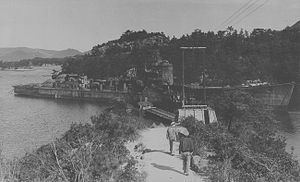Name Suzutsuki Completed 29 December 1942 Construction started 15 March 1941 Length 134 m | Laid down 15 March 1941 Struck 20 November 1945 Launched 4 March 1942 | |
 | ||
Commissioned 29 December 1942 Yokosuka Chinjufu Class and type Akizuki-class destroyer Builder Mitsubishi Nagasaki Shipyard | ||
Suzutsuki (涼月) was an Akizuki-class destroyer of the Imperial Japanese Navy. Her name means "Clear Moon (in Autumn)".
Contents
Design and description
The Akizuki-class ships were originally designed as anti-aircraft escorts for carrier battle groups, but were modified with torpedo tubes and depth charges to meet the need for more general-purpose destroyer. Her crew numbered 300 officers and enlisted men. The ships measured 134.2 meters (440 ft 3 in) overall, with a beam of 11.6 meters (38 ft 1 in) and a draft of 4.15 meters (13 ft 7 in). They displaced 2,744 metric tons (2,701 long tons) at standard load and 3,759 metric tons (3,700 long tons) at deep load.
The ships had two Kampon geared steam turbines, each driving one propeller shaft, using steam provided by three Kampon water-tube boilers. The turbines were rated at a total of 52,000 shaft horsepower (39,000 kW) for a designed speed of 33 knots (61 km/h; 38 mph). The ships carried up to 1,097 long tons (1,115 t) of fuel oil which gave them a range of 8,300 nautical miles (15,400 km; 9,600 mi) at a speed of 18 knots (33 km/h; 21 mph).
The main armament of the Akizuki class consisted of eight Type 98 100-millimeter (3.9 in) dual purpose guns in four twin-gun turrets, two superfiring pairs fore and aft of the superstructure. They carried four Type 96 25-millimeter (1.0 in) anti-aircraft guns in two twin-gun mounts. The ships were also armed with four 610-millimeter (24.0 in) torpedo tubes in a single quadruple traversing mount; one reload was carried for each tube. Their anti-submarine weapons comprised six depth charge throwers for which 72 depth charges were carried.
Construction and career
On 6–7 April 1945, Suzutsuki escorted the battleship Yamato from the Inland Sea on her attack mission against the Allied forces fighting on Okinawa. Her bow was torn off by a torpedo from aircraft of Task Force 58, but survived and returned to Sasebo, by steaming in reverse the whole way. She, her sister Fuyutsuki, Yukikaze, and Hatsushimo (sunk in late July by a mine off the Inland Sea), survived the ordeal, despite suffering heavy damage, but Yamato, and five escorts, Yahagi, Asashimo, Kasumi, Hamakaze and Isokaze were all sunk with heavy losses of life. Some of the survivors were picked up by Suzutsuki.
Following the end of the war, Suzutsuki was initially used as a breakwater at Takamatsu in November 1945, then was sold for scrap that same month after her name was delisted from the Navy List on 20 November.
